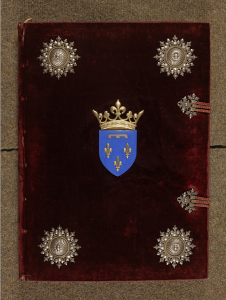
Codex Chantilly: the electrifying page-turner that blew the lid off the perverse musical excesses of the late Middle Ages!
NOTE: I am a known perpetrator of musical hoaxes, but this isn’t one of them. This bizarre composition really is over 600 years old.
As Marsellus Wallace once quipped: “I’m’a get medieval on your ass.”
I’ve been obsessing again on a medieval composition that’s fascinated me since my geeky teens. It’s Fumeux fume par fumee, a bizarre artifact from a bizarre moment in music history: France in the final years of the 14th century.
(If you’re wondering why I was listening to medieval and Renaissance music when I was 17 instead of Zep and Floyd, and what the stuff brings to my guitar playing today, read on. But first, that freaky music!)
The world that produced Fumeux fume par fumee wasn’t your storybook Middle Ages. We’re talking Hundred Years War, Black Death, Papal Schism — and a radical musical style of head-spinning complexity and abstraction. It was dissonant music for dissonant times. The death rattle of the Dark Ages.
The 14th century had witnessed the rise of ars nova, a florid and intellectual style characterized by bold new approaches to counterpoint and musical structure. But by the 1380s or so, ars nova had mutated into ars subtilior, an even more abstract and experimental style.
“Ars nova” means “new art.” It was.
“Ars subtilior” means “more subtle art.” It wasn’t — unless by “subtle,” you mean “characterized by extreme dissonance and chaotic rhythms.” And Fumeux is a perfect embodiment of this radical style.
Here’s what I’m talking about:
WTF, right?
You probably don’t need me to specify why this music is so freaky, but I will anyway:
- It’s freakishly chromatic.
- It’s freakishly low-pitched.
- Its rhythms are freakishly complex.
- It may have been inspired by a freaky drug cult.
Fumeaux is one of a dozen Codex Chantilly compositions attributed to Solage, a composer about whom we know nothing. However, the song’s cryptic text may refer to an artsy-fartsy smoking club/cult. And in those pre-Columbian days, tobacco was unknown in Europe, so they would have been smoking either hash or opium.
A smoker smokes through smoke
A smoky speculation.
Is, between puffs, his thought:
A smoker smokes through smoke.
For smoking suits him very well
As long as he keeps his intention.
A smoker smokes through smoke
A smoky speculation.
And there are some who believe that reefer-puffin’ jazz cats and acid-baked hippies were the first to combine music and drugs!
Was Solage part of this crowd? Or was he lampooning them with ear-twisting sonorities? We don’t know — though we can probably assume he was a member of one of the avant-garde circles in Paris or Avignon. Here’s part of the original manuscript:
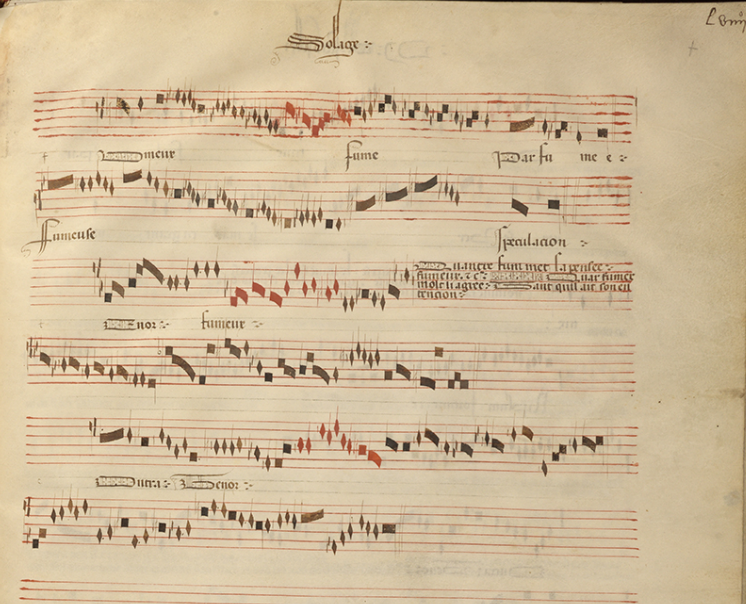
Nope, I’m not reading from that — I worked from a modern edition you can download here. But despite its six-line staff and multi-color note heads (the red ink indicates rhythmic variations), you can at least recognize this as an ancestor of modern notation. That’s less true of these Codex pages, which feature two pieces by a composer named Baude Cordier:
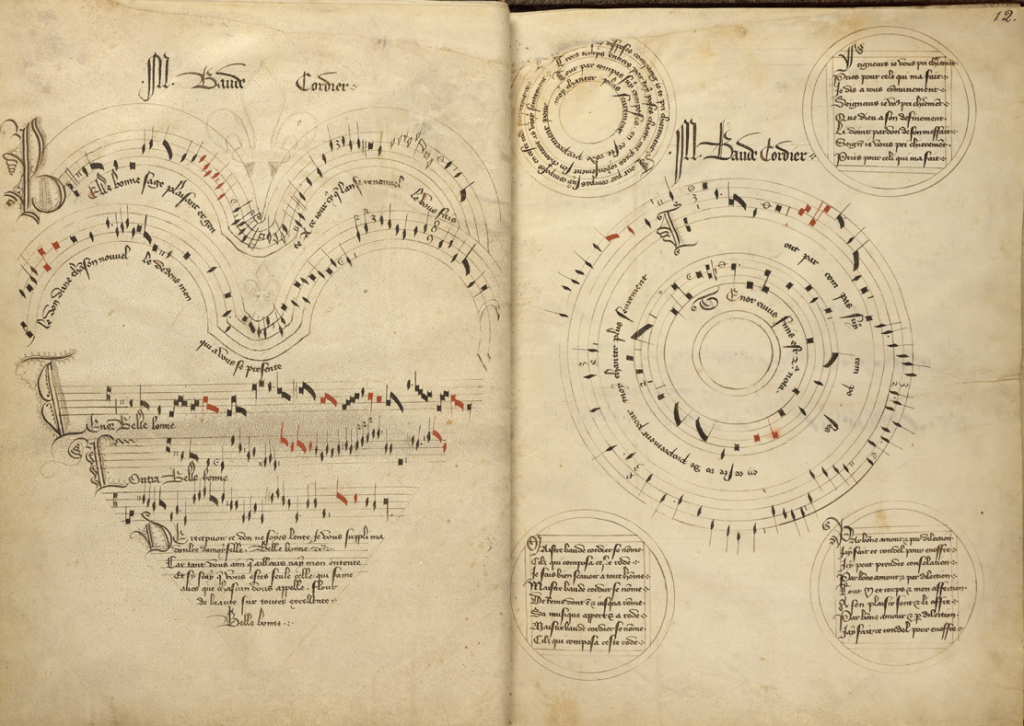
A medieval musical valentine?
On the left is Belle, Bonne, Sage, a courtly love song notated in the form of a heart. (Or maybe it’s a pun of the composer’s name, which sounds like “couer,” the French word for “heart.”) On the right is an “endless canon,” a piece whose melodies echo and circle each other like a brainiac version of “Row, Row, Row Your Boat.” It’s called Tout par compas suy composés — “I was composed with a compass.”
Clever.
I originally tried recording this on acoustic guitar, but the three low-pitched parts sounded too muddy. It just worked better with pick-style baritone guitar. And while Solage probably never envisioned his music being played by a trio of Fender Bass VIs, the choice isn’t as ludicrous as you might think. Music of this era was almost never composed with specific instruments in mind — it was understood that the parts could be played by any available combination of voices and/or instruments. It wasn’t until the later Renaissance that composers began to create specialized parts for specific instruments, and the concept of orchestration was born. (Though orchestras as we think of them didn’t exist until the 18th century.)
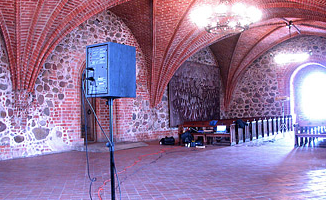
Features genuine 14th-century reverb!
Oddly, the most historically authentic aspect of my recording may be its digital reverb. I ran the performance through an Altiverb impulse reponse reverb created in an actual 14th-century castle. (You can read more about the magic of impulse response reverbs here.)
I’ve marveled at this piece for decades, but never tried playing it till I tracked this yesterday. Getting “under the hood” with it only deepens my fascination.
How did I get turned on to it? At 17, I was convinced my destiny was to be a scholar of early music (the catch-all term for European art music before Bach). I studied the Renaissance lute in college. (When anyone asked my folks what their son was studying at UCLA, they’d reply: “Lute. He’s going to be a shepherd.”)
I switched to a composition major in grad school, and haven’t owned a lute in decades. But years later, when I decided to focus on fingerstyle electric guitar playing, I instinctively adopted something like a lutenist’s right-hand technique. It’s not terribly different from classical guitar technique, except that I almost never use a classical guitarist’s “rest strokes” (bringing a finger to rest on an adjacent string after plucking). Also, while a classical guitarist tends to play melodies with alternating index and middle fingers, I usually play them with alternating thumb and index finger, lute-style. (You can take the boy out of the Renaissance Faire, but you can’t…)
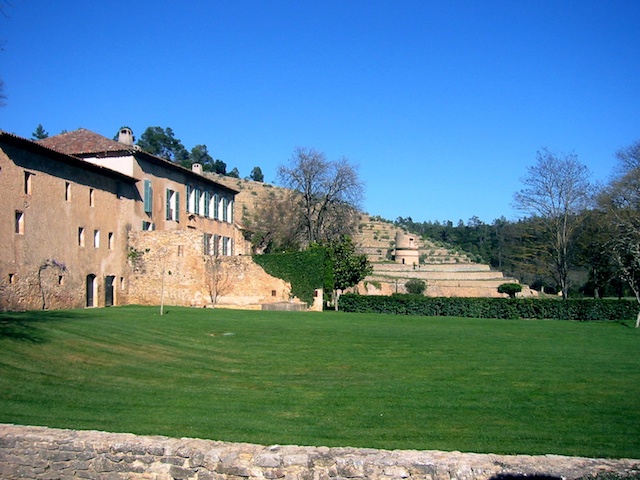
The chateau was a peaceful place — while Courtney was asleep.
Funny epilogue: Ten years ago I was trying to record a Courtney Love album at a beautiful chateau in Southern France, the same studio where Floyd tracked The Wall. We weren’t far from Avignon, where this music may have originated. One night at dinner Courtney injected some casual comment about 14th-century compositional techniques. She may have gleaned it from Richard Hostatder’s Gödel, Escher, Bach. Or she may have just been fucking with me. (Reading up on you online so she can “casually” drop a mind-blowing comment into a conversation is very much Courtney’s style.) That led to a discussion of French poetry, and the studio manager recalled with admiration the way Robert Smith used to sit around that same table reciting symbolist poetry — in the original French, of course — while the Cure was recording Kiss Me Kiss Me Kiss Me. Occasionally rock stars are really smart.
The studio went under soon after, largely because Courtney neglected to pay her astronomical bills. Today the chateau, studio, and winery are the country estate of Brad Pitt and Angelina Jolie. I wonder if they ever discuss 14th-century counterpoint and the ars subtilior.
P.S.: If you’re curious about this remarkable juncture in history, check out Barbara Tuchman’s classic A Distant Mirror: The Calamitous 14th Century, a riveting history book suitable for general readers.








I feel positively dull.
Fascinating. Thank you so much for posting that.
Joe, only you could (or would) have thought to post this article and had the insight to write it, and that is why you rock.
I think that’s the nicest way anyone has ever called me a weirdo! 🙂
ha, awesome! Thanks for sharing that. So, did you get paid for the session at least?
I got half my money. I was one of the lucky ones. 😉
Godel, Escher, Bach ! Wow ! Not something I would expect to see on a guitar based site Joe . There is something so wrong and different about that piece for the 14th century it just hurts my brain.Regressing back into my childhood (completely random events that led me to those sorts of things).Just the sort of thing I need to see first thing in the morning to beat me into submission! Very neat stuff ! You go to the front of the line , free pass and 200 bucks!
It makes me wonder if the cult/club thing had some secret way of interpreting these parts. It sounds as if the music is encrypted somehow. Perhaps you’re supposed to shift the inner voices over two beats and play everything a 5th up. Once you learned the secret handshake, they taught you their musical code.
well, while I’m pulling this out of the dusty brain archives and it should be double checked, the possible implication of a cult, smoking, and the the date could likely be referencing some of the alchemist cults of the 13th and 14th centuries which, according to their symbology, employed cannabis either in their potions or to ‘facilitate’ the search. So, if you’ve got a bunch of half-baked pseudo scientists who are carving and gilding pot leaves into their architecture, then it’s entirely conceivable that they would think it pretty sweet to code something into their music – if not only in the lyrics. It’s unlikely that they were smoking opium because while the romans had employed it medicinally, it seems to have been absent in europe for a couple centuries until the Portuguese opened the eastern trade routes again in the early 15th century.
sooo….., my guess is that the red notes indicate where you take a hit…
That would definitely simplify the rhythm.
That’s not as far-fetched as it may seem. There’s often a great emphasis of symbolism and numerology in medieval and early Renaissance music.
But not always. Last time I was on tour in Florence, I amazed my bandmates with the fact that Guillaume Dufay composed a piece honoring the construction of Bruneleschi’s dome for the great cathedral, with all the architectural ratios mirrored in the musical structure. Back at the hotel I checked Wikipedia for some detail — only to learn that the entire theory had been soundly debunked since I learned it in school ages ago.
The only thing worse than being an insufferable know-it-all is being an insufferable know-it-all whose info is wrong. 😉
Have I told you about the secret to the Stradivarius violins yet? ……..
Virgin’s blood in the.varnish?
that’s a good one! I heard they were carved with unicorn horns though…
Best thing I’ve read/heard on a guitargeek site in a while. Nutritious and educational.
🙂
To me, it sort of sounds like The Shaggs from the Dark Ages. But seriously, it’s really interesting. Greetings from Spain, love your blog.
Hi Freddie —
You know what? The Shaggs have always sounded medieval to me. I think it’s because medieval music doesn’t have “chord progression” underpinnings. The harmony results solely from the intersecting melodies. Melodies aren’t “strung across” a chordal framework. They’re less like cables on a suspension bridge, and more like threads in a spider web. It’s very different from how we in the West have perceived music for the last few centuries. I get a very similar “alien music” feeling from the Shaggs and certain medieval polyphony. 🙂
This ars nova in France…, you could find a better word.
Yeah, it does sound a little too much like “tear ya a new one,” doesn’t it?
OK, so while wasting my lunch time on a site for gear-heads called Guitar Moves (web-video-interview-about-people-I-know-nothing-about, site) I hear the familiar ping of facebook telling me someone (hopefully) posted something of interest. Lo (and behold) there is Rik with a post saying that “you can always trust Joe Gore to find something interesting.” And he was correct.
While listening to the Solage piece (very well done, btw) I was following along on the transcription. Before I pass the bong, did anyone else hear some of the phrases that sounded mysteriously like passages from Gentle Giant’s Octopus? Or should I have passed the bong an hour ago?
Wonderful, JG! Love this! :thumbup:
Terrific! I could listen to that all day. Thanks!
ps. the Tuchman book is great
amazing; if you’ve recorded the rest of the dozen Solange pieces from the manuscript, or anything similar I’d be interested in a copy!
Thanks, man! I haven’t — but I might! 🙂
Gorgeous stuff! All rock and no history makes any guitar player a dull boy.
looking at those cordier charts, it’s easy to see how george crumb became george crumb.
Oh, I’m sure Crumb was VERY aware of this manuscript!
Hehehe — my wife just got this mailer from BevMo. It’s another view of the notorious former recording studio/chateau. Brad and Angelina must have improved the wine — it was perfectly tasty, but definitely not a 90. 🙂